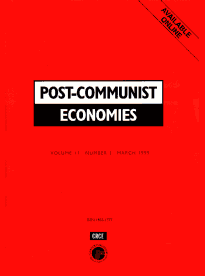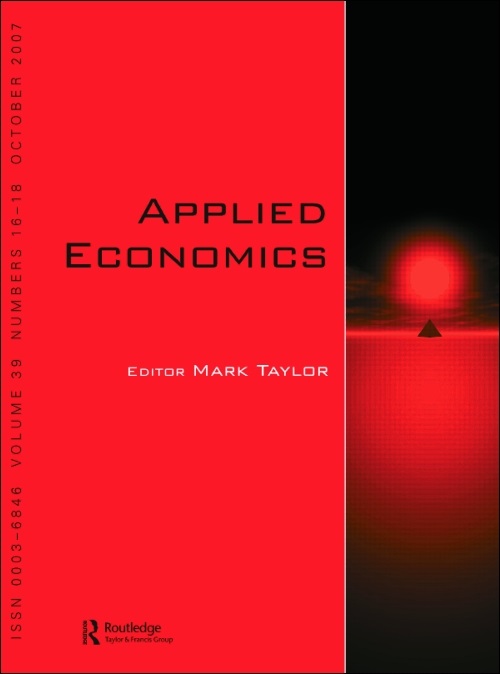
Extreme Risks in Financial Markets and Monetary Policies of the Euro-candidates
in: Comparative Economic Studies, No. 4, 2011
Abstract
This study investigates extreme tail risks in financial markets of the euro-candidate countries and their implications for monetary policies. Our empirical tests show the prevalence of extreme risks in the conditional volatility series of selected financial variables, that is, interbank rates, equity market indexes and exchange rates. We argue that excessive instability of key target and instrument variables should be mitigated by monetary policies. Central banks in these countries will be well-advised to use both standard and unorthodox (discretionary) tools of monetary policy while steering their economies out of the financial crisis and through the euro-convergence process.

Central and Eastern European Countries in the Global Financial Crisis: A Typical Twin Crisis?
in: Post-Communist Economies, No. 4, 2011
Abstract
This paper shows that during the Great Recession, banking and currency crises occurred simultaneously in Central and Eastern Europe. Events, however, differed widely from what happened during the Asian crisis that usually serves as the model case for the concept of twin crises. We look at three elements that help explaining the nature of events in Central and Eastern Europe: the problem of currency mismatches, the relation between currency and banking crises, and the importance of multinational banks for financial stability. It is shown that theoretical considerations concerning internal capital markets of multinational banks help understand what happened on capital markets and in the financial sector of the region. We discuss opposing effects of multinational banking on financial stability and find that institutional differences are the key to understand differing effects of the global financial crisis. In particular, we argue that it matters if international activities are organized by subsidiaries or by cross-border financial services, how large the share of foreign currency-denominated credit is and whether the exchange rate is fixed or flexible. Based on these three criteria we give an explanation why the pattern of the crisis in the Baltic States differed markedly from that in Poland and the Czech Republic, the two largest countries of the region.

Inflation and Relative Price Variability in the Euro Area: Evidence from a Panel Threshold Model
in: Applied Economics, No. 4, 2012
Abstract
The impact of inflation on Relative Price Variability (RPV) generates an important channel for real effects of inflation. This article provides first evidence on the empirical relation between inflation and RPV in the euro area. Stirred by the widespread use of inflation caps or target bands in monetary policy practice, we are particularly interested in threshold effects of inflation. In line with the predictions of monetary search models, our results indicate that expected inflation significantly increases RPV only if inflation is either very low (below 0.95% per annum (p.a.)) or very high (above 4.96% p.a.).

Interest Rate Convergence in the Euro-Candidate Countries: Volatility Dynamics of Sovereign Bond Yields
in: Emerging Markets Finance and Trade, 2010
Abstract
We argue that a “static“ specification of the Maastricht criterion for long-term bond yields is not conducive to assessing stability of financial systems in euro-candidate countries. Instead, we advocate a dynamic approach to assessing interest rate convergence to a common currency that is based on the analysis of financial system stability. Accordingly, we empirically test volatility dynamics of the ten-year sovereign bond yields of the 2004 EU accession countries in relation to the eurozone yields during the January 2, 2001-January 22, 2009, sample period. Our results show a varied degree of the relationship between domestic and eurozone sovereign bond yields, the most pronounced for the Czech Republic, Slovenia, and Poland, and weaker for Hungary and Slovakia. We find some divergence of relative bond yields since the EU accession.

A Cost Efficient International Lender of Last Resort
in: International Research Journal of Finance and Economics, 2010
Abstract
The current reform of the International Monetary Fund’s (IMF) lending instruments has transformed the Fund towards an international lender of last resort (ILOLR). Current research discusses various general frameworks for installing an ILOLR. However, it remains unclear how the ILOLR should actually operate. This paper discusses six different options for the construction of an ILOLR that supports central banks during currency crises. The paper concludes that the most cost efficient version of the ILOLR would be direct intervention by the IMF using IMF resources, with the option of using additional reserves from central banks. The paper considers measures of cost efficiency, such as cost of borrowing, intervention, and sterilization and moral hazard problems.



